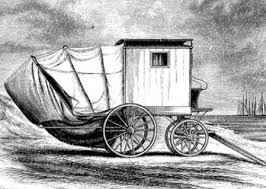 |
| Mermaids at Brighton, 1829, by William Heath |
‘Tis summer and many a hot
and bothered person longs to take a plunge into the invigorating chill of ocean
waves. How about our 18th century relations? Did they do likewise?
It seems our ancestors were more inclined to take to the sea for medicinal
purposes rather than recreational ones. A
 |
| Dr. Russell's book |
 |
Advertisement for Bathing Machines at Margate, England, 1791
|
book published in 1752, A Dissertation on the Use of
Seawater in the Diseases of the Glands by Dr. Richard Russell, trumpeted the benefits of dipping into the salt
water and greatly increased the popularity of the practice. So for their
health’s sake, men and women, alike, braved the seas (albeit separately.)
Enter the Bathing Machine,
an invention which showed up on beaches in the first half of the 1700s; a
contrivance with which people could take a dip into the sea without risking
their modest virtue. The machine was basically a dressing room on wheels that
was pulled into the ocean by a horse. Although there were variations, most
followed this basic routine: individuals entered the beached machines, fully
dressed, by climbing a set of steps and disappearing into the privacy of the
wooden box. There was usually a window set high in the machine to let in light
but not allow prying eyes to view the bather. Once inside, bathers would remove
their street clothes and don their bathing togs (although bathing in the nude
was often the norm, at least for men, until 1862,) then signal their guide to
take them out to sea.
Once in place, the horse was unhitched and led ashore to
pull out another machine or retrieve a bather ready to come back to dry land.
An attendant, of the same sex as the bather,
was at the ready to assist the
bather as necessary to descend the steps leading down from the end of the
machine facing out to sea. Since many
bathers could not swim the attendant, also known as a “Dipper,” would either help keep
 |
| Dipper, Martha Gunn, 1790, Artist unknown |
them afloat or actually push
them under the water and lift them back up again, three plunges being the norm
for health benefits. Dippers were usually very sturdy folk. A portrait of Brighton Beach's most famous Dipper, Martha Gunn, speaks to that asset. In 1750, an English Quaker glove and breeches maker by the
name of Benjamin Beale invented a canvas hood, covering the seaward steps, that
could be lowered and completely conceal the bathers until they were under the
protection of the water’s surface. Some even remained beneath the hood during
the entire bathing experience thus avoiding any chance of being seen.
 |
| Bathing Machine with Benjamin Beal's Modesty Hood, artist unknown |
When the bathing session was
over, bathers would climb back into their machines and signal (sometimes by
raising flags) their desire to return to the beach. Once back inside the
privacy of their bathing machines, they would dry off and dress back into their
street wear. Returned to the beach, bathers would descend the steps in the
clothes in which they arrived. Mission accomplished, reputations intact, thank
you very much.
Have a good week, dear
Reader. Thanks for stopping by...Y'all come back now! (Don't forget the water wings and sunscreen!)
Kate

No comments:
Post a Comment